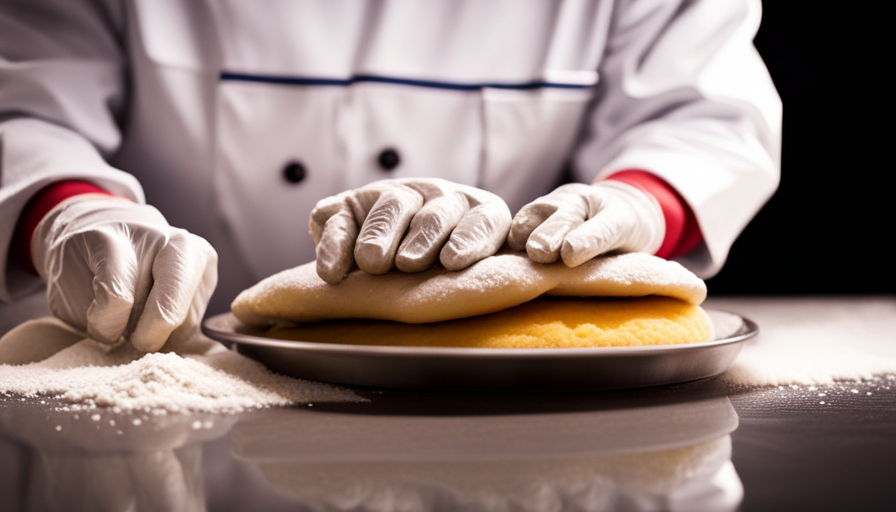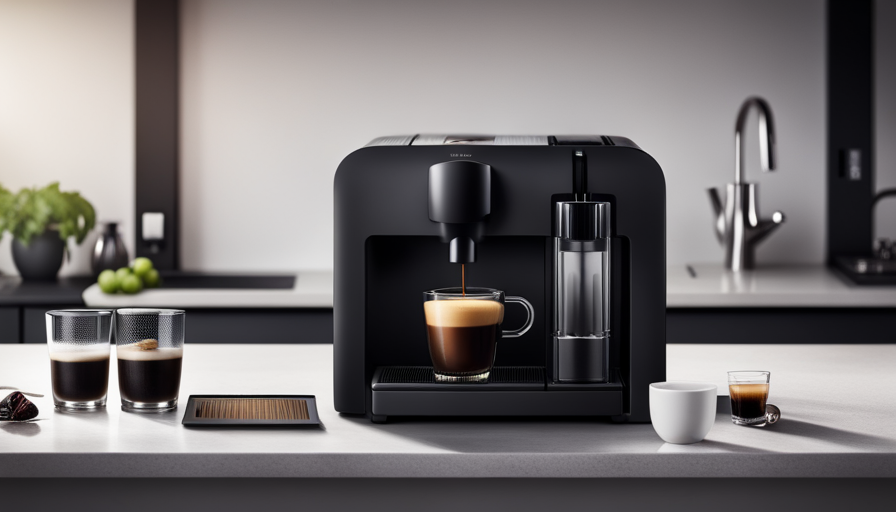Benefits of Raw Food
Must Fast Food Places Wear Gloves When Handling Raw Dough?

Picture this situation: You enter your go-to fast food joint, looking forward to enjoying a hot, soft delicacy. Observing the staff skillfully working with the uncooked dough, a question pops into your head – are they using gloves? Is it necessary for fast food outlets to mandate glove use during the handling of raw dough?
The answer is a resounding yes. Not only is it a matter of hygiene, but it also plays a crucial role in preventing contamination and ensuring food safety. In this article, we will delve into the importance of food safety standards and explore the health risks associated with raw dough. We will discuss the role gloves play in maintaining hygiene in the fast food industry, as well as proper handwashing techniques for dough handling.
Compliance with health regulations, implementing cross-contamination prevention measures, and regular cleaning and sanitization of workstations are also key factors in safe dough handling. Join us as we uncover the best practices that fast food places must adopt to protect both their customers and their reputation.
Key Takeaways
- Fast food places should prioritize food safety by requiring employees to wear gloves when handling raw dough.
- Compliance with health regulations and cross-contamination prevention measures is important in safe dough handling.
- Consuming undercooked dough can lead to foodborne illnesses, as raw dough may contain pathogens like Salmonella and E. coli.
- Proper hand hygiene, including thorough handwashing with soap and warm water, is essential for preventing dough contamination.
Understanding the Importance of Food Safety Standards
You’ll want to understand the importance of food safety standards because they directly impact the quality and safety of the food you consume. Fast food places, like any other food establishment, have a responsibility to ensure that the food they serve is safe for consumption.
One of the key reasons for this is to prevent foodborne illness outbreaks. Foodborne illness outbreaks can occur when food is contaminated with harmful bacteria, viruses, or parasites. These pathogens can cause a range of symptoms, from mild stomach discomfort to severe illness and even death. By following food safety standards, fast food places can minimize the risk of contamination and protect their customers from potential harm.
Temperature control is a crucial aspect of food safety. Bacteria can multiply rapidly in the temperature danger zone, which is between 40°F and 140°F (4°C and 60°C). This means that if raw dough, for example, is not handled properly, bacteria can multiply and cause foodborne illnesses. By wearing gloves when handling raw dough, fast food workers can prevent direct contact between their hands and the dough, reducing the risk of contamination.
Understanding the importance of food safety standards is essential for fast food places. By following these standards, they can prevent foodborne illness outbreaks and ensure that the food they serve is safe for consumption. Proper temperature control, including wearing gloves when handling raw dough, plays a vital role in maintaining food safety.
Exploring Health Risks Associated with Raw Dough
Imagine the potential health risks that come with working with uncooked dough. Handling raw dough in fast food places without gloves can lead to serious health consequences.
Here are some important points to consider:
-
Consuming undercooked dough can lead to foodborne illnesses. Raw dough contains harmful bacteria and pathogens that can cause infections in the digestive system. These can result in symptoms such as nausea, abdominal pain, vomiting, and diarrhea.
-
One of the most common pathogens found in raw dough is Salmonella. This bacterium can cause severe food poisoning, especially when ingested in large quantities. It can lead to dehydration, high fever, and even hospitalization in some cases.
-
Another risk is the presence of E. coli in raw dough. This bacteria can cause severe gastrointestinal issues and can even lead to kidney failure in some cases. It’s particularly dangerous for young children, pregnant women, and individuals with weakened immune systems.
It is crucial for fast food places to prioritize food safety by requiring their employees to wear gloves when handling raw dough. This simple step can greatly reduce the risk of contamination and protect customers from potential health hazards.
Remember, proper food handling practices can go a long way in ensuring the safety and well-being of everyone.
The Role of Gloves in Preventing Contamination
Gloves play a crucial role in preventing contamination and ensuring the safety of individuals when working with uncooked dough. They act as a barrier between the dough and the hands, preventing any potential transfer of bacteria or other harmful substances.
While gloves are the most common method of protecting against contamination, there are also alternative dough handling methods that can be used. One alternative is the use of utensils, such as spatulas or tongs, to handle the dough. This minimizes the contact between the dough and the hands, reducing the risk of contamination.
Another option is to use disposable plastic bags or wrap the hands in plastic wrap. These methods provide a barrier similar to gloves and can be easily discarded after use.
It is important to note that while gloves are effective in preventing contamination, they are not the only solution. Proper hand hygiene is also essential in ensuring the safety of the dough. This includes washing hands thoroughly with soap and water before and after handling the dough.
Gloves are an important tool in preventing contamination when working with raw dough. However, there are alternative dough handling methods available, such as using utensils or disposable plastic bags. Regardless of the method used, it is crucial to prioritize hand hygiene to ensure the safety of the dough and the individuals handling it.
Maintaining Hygiene in the Fast Food Industry
Maintaining proper hygiene is crucial in the fast food industry to ensure the safety of both the food and the customers. In order to prevent foodborne illnesses and ensure that the food handling procedures are up to standard, fast food places must take the following steps:
-
Regular handwashing: Hands are the most common carriers of bacteria and viruses, so it’s essential for all employees to wash their hands frequently and thoroughly with soap and water. This should be done before and after handling any food products.
-
Proper glove usage: Although gloves aren’t always required when handling raw dough, they should be worn when there’s a risk of direct hand contact with the food. Gloves act as a barrier between hands and food, preventing the transfer of bacteria.
-
Regular cleaning and sanitizing: All surfaces, utensils, and equipment used in the food preparation area should be regularly cleaned and sanitized to minimize the risk of cross-contamination. This includes countertops, cutting boards, knives, and mixing bowls.
-
Employee training: Proper training is essential to ensure that all employees are aware of and follow the correct food handling procedures. This includes understanding the importance of hygiene, knowing how to properly wash hands, and knowing when gloves should be worn.
By implementing these measures, fast food places can maintain a high standard of hygiene and reduce the risk of foodborne illnesses, ensuring the safety of both the food and the customers.
Proper Handwashing Techniques for Dough Handling
When you’re working with dough, it’s important to thoroughly wash your hands using the proper technique to ensure the safety and cleanliness of the final product. Handwashing guidelines for dough handling are crucial in preventing any potential contamination.
To start, always wet your hands with warm water and apply enough soap to create a good lather. Make sure to scrub all surfaces of your hands, including the back, between the fingers, and under the nails. This thorough scrubbing should last for at least 20 seconds.
Rinse your hands well under running water to remove all soap residue.
After rinsing, use a clean towel or air dryer to dry your hands completely. Avoid using clothing or other unclean surfaces to dry your hands, as they may introduce new bacteria.
It’s also important to note that hand sanitizers are not a substitute for proper handwashing when handling dough. They may not effectively remove all types of bacteria or contaminants that can be present in raw dough.
By following these handwashing guidelines, you can significantly reduce the risk of dough contamination. Proper handwashing techniques ensure that any potential harmful bacteria are eliminated, maintaining the safety and cleanliness of the final product.
Remember, clean hands are crucial in the fast-food industry to protect the health of both workers and customers. So, take the time to wash your hands properly when handling dough and contribute to a hygienic and safe food environment.
Training and Education for Food Handlers
One key aspect to ensuring food safety and hygiene in the fast-food industry is providing comprehensive training and education for all food handlers. It’s crucial for fast-food places to prioritize the training and education of their employees, especially when it comes to handling raw dough. Food handler certification programs play a vital role in equipping food handlers with the necessary knowledge and skills to handle food safely.
These certification programs cover a wide range of topics, including proper handwashing techniques, personal hygiene, and the importance of using gloves when handling raw dough. Food handlers learn about the potential hazards associated with dough handling, such as cross-contamination and the risk of foodborne illnesses. They also learn about the proper procedures for storing dough to prevent spoilage and maintain its quality.
In addition to food handler certification, proper food storage is another crucial aspect of training and education for fast-food employees. They’re taught the importance of storing dough in clean and sanitized containers, at the correct temperature, and away from other potentially contaminated food items. By adhering to these guidelines, fast-food establishments can minimize the risk of foodborne illnesses and ensure the safety and quality of their products.
Overall, training and education play a critical role in maintaining food safety and hygiene in the fast-food industry. By providing food handler certification programs and emphasizing proper food storage practices, fast-food places can ensure that their employees are knowledgeable and equipped to handle raw dough safely.
Compliance with Health Regulations
Ensuring compliance with health regulations is crucial for the fast-food industry, with studies showing that establishments that consistently follow these guidelines have a significantly lower incidence of foodborne illnesses. Fast-food places must adhere to food safety guidelines and regulatory compliance to protect the health and well-being of their customers.
To emphasize the importance of compliance, let’s take a look at a table that highlights the potential consequences of non-compliance with health regulations:
| Non-Compliance with Health Regulations | Consequences |
|---|---|
| Improper handwashing | Spread of bacteria and viruses |
| Failure to maintain proper food temperatures | Growth of harmful bacteria |
| Cross-contamination of raw and cooked foods | Risk of foodborne illness |
| Poor sanitation practices | Increased risk of contamination |
| Lack of employee training and education | Increased likelihood of mistakes |
As you can see, non-compliance with health regulations can lead to serious consequences, including the spread of bacteria and viruses, the growth of harmful bacteria, and an increased risk of foodborne illness. It is essential for fast-food places to prioritize regulatory compliance to protect the health and safety of their customers.
By following food safety guidelines and regulatory compliance, fast-food establishments can maintain a clean and safe environment, ensuring that the food they serve is free from contaminants. This not only protects the customers but also helps to build trust and loyalty among patrons. Therefore, it is essential for fast-food places to prioritize compliance with health regulations to uphold the highest standards of food safety.
Implementing Cross-Contamination Prevention Measures
To effectively prevent cross-contamination, fast-food establishments can implement measures such as using separate cutting boards and utensils for raw and cooked foods. By doing so, they can significantly reduce the cross-contamination risks and prevent foodborne illnesses.
One of the main concerns when handling raw dough in fast-food places is the potential transfer of harmful bacteria to other food items. Raw dough can contain pathogens like Salmonella or E. coli, which can cause serious illnesses if ingested. Therefore, it’s crucial to take preventive measures to avoid cross-contamination.
Using separate cutting boards and utensils for raw and cooked foods is an effective way to prevent cross-contamination. This ensures that any bacteria present in the raw dough doesn’t come into contact with ready-to-eat foods. Additionally, regular cleaning and sanitizing of these surfaces is essential to eliminate any remaining bacteria.
Another measure that fast-food establishments can adopt is proper hand hygiene. Employees should wash their hands thoroughly before and after handling raw dough. This helps minimize the risk of transferring pathogens from the dough to other surfaces or food items.
Fast-food places must implement cross-contamination prevention measures to ensure food safety and prevent foodborne illnesses. By using separate cutting boards and utensils for raw and cooked foods, and practicing proper hand hygiene, they can effectively reduce the risk of cross-contamination and protect their customers from potential harm.
Regular Cleaning and Sanitization of Workstations
Regularly cleaning and sanitizing workstations is crucial for maintaining a safe and hygienic environment in fast-food establishments. Proper workstation maintenance is essential to prevent the spread of foodborne illnesses and ensure the safety of both employees and customers.
To start, it’s important to clean all work surfaces thoroughly after each use. This includes countertops, cutting boards, and utensils. Use hot, soapy water and a scrub brush to remove any food particles or residues. Pay special attention to areas that come into direct contact with raw dough, as this is where cross-contamination is most likely to occur.
In addition to regular cleaning, sanitization is key in eliminating harmful bacteria and preventing the spread of pathogens. Use a sanitizer approved for food contact surfaces and follow the manufacturer’s instructions for proper dilution and application. Make sure to sanitize all surfaces, including those that are frequently touched, such as door handles and light switches.
By incorporating regular cleaning and sanitization practices into your daily routine, you can significantly reduce the risk of foodborne illnesses in your fast-food establishment. Remember, maintaining a clean and hygienic workspace is not only important for compliance with health regulations, but also for the health and well-being of your staff and customers.
Best Practices for Safe Dough Handling
Keep your hands clean and properly practice safe dough handling to ensure a sanitary and secure environment in your fast-food establishment. Safe dough handling is crucial to prevent foodborne illnesses and maintain the quality of your products. Here are some best practices to follow:
-
Safe dough storage: Store dough in clean, covered containers to prevent contamination from airborne bacteria or pests. Keep it at the appropriate temperature to avoid bacterial growth.
-
Hand hygiene: Wash your hands thoroughly before and after handling dough. Use warm water and soap, scrubbing for at least 20 seconds. Dry your hands with a clean towel or air dryer.
-
Gloves: While gloves aren’t mandatory for handling dough, they provide an additional layer of protection. If you choose to wear gloves, ensure they’re clean and change them regularly to avoid cross-contamination.
-
Equipment cleanliness: Regularly clean and sanitize all equipment used for dough handling, including mixing bowls, utensils, and work surfaces. Use approved sanitizers and follow proper cleaning procedures.
-
Cross-contamination prevention: Keep raw dough separate from ready-to-eat foods to avoid cross-contamination. Use separate utensils and work areas to prevent the spread of harmful bacteria.
By following these best practices, you can maintain a safe and healthy environment in your fast-food establishment, keeping your customers and staff protected from foodborne illnesses.
Frequently Asked Questions
What are the common health risks associated with handling raw dough in fast food places?
When handling raw dough in fast food places, there are several health risks to consider. One common risk is the potential for bacterial contamination, as raw dough may contain harmful bacteria such as Salmonella or E. coli. These bacteria can cause foodborne illnesses if ingested.
Additionally, handling dough without gloves can lead to skin irritation or allergic reactions, especially for individuals with sensitivities to certain ingredients. Therefore, it’s important for fast food places to prioritize safety and implement proper hygiene practices when handling raw dough.
How often should food handlers wash their hands when handling dough?
When handling dough, it’s crucial for food handlers to follow proper hand hygiene guidelines. According to handwashing frequency recommendations, food handlers should wash their hands before starting their shift, after using the restroom, before and after handling raw ingredients like dough, and after any tasks that may contaminate their hands.
Regular and thorough handwashing is essential to prevent the spread of harmful bacteria and ensure food safety in fast food places.
What specific regulations exist regarding the use of gloves in the fast food industry?
In the fast food industry, specific regulations exist regarding the use of gloves to ensure food safety and maintain hand hygiene.
Glove requirements are in place to prevent cross-contamination and protect against the spread of harmful bacteria.
Fast food establishments are required to provide and enforce the use of gloves when handling food, including raw dough.
This helps to minimize the risk of foodborne illnesses and maintain a high standard of cleanliness in the industry.
Hand hygiene practices, such as regular handwashing, should also be followed in conjunction with glove usage.
Are there any additional measures fast food places should take to prevent cross-contamination in dough handling?
To prevent contamination and ensure proper sanitation, fast food places should take additional measures when handling dough. It’s like building a fortress to protect against the enemy of cross-contamination.
One crucial step is to maintain a separate area solely for dough preparation, away from any potential sources of contamination. Regularly cleaning and sanitizing all surfaces and utensils is also essential.
By implementing these measures, fast food places can safeguard their dough and ensure the highest standards of food safety.
What are the best practices for ensuring safe dough handling in fast food establishments?
To ensure safe dough handling in fast food establishments, it’s crucial to follow best practices and maintain proper hygiene. Start by thoroughly washing your hands before and after handling dough. Use gloves to prevent contamination and ensure the dough remains safe for consumption.
Additionally, regularly sanitize work surfaces and equipment to avoid cross-contamination. By adhering to these practices, fast food establishments can prioritize food safety and provide customers with a safe dining experience.
Should Fast Food Places Always Wear Gloves When Handling Raw Dough?
When it comes to handling raw dough, fast food places should prioritize changing gloves when handling food to prevent cross-contamination. This simple precaution can help maintain food safety and ensure that customers are not at risk of getting sick from germs or bacteria transferred from other food items.
Conclusion
In conclusion, wearing gloves when handling raw dough in fast food places is essential for ensuring food safety and preventing contamination. Just like a knight wears armor to protect themselves in battle, gloves act as a shield against harmful bacteria that can lurk in raw dough.
By following proper handwashing techniques, complying with health regulations, and implementing cross-contamination prevention measures, fast food establishments can maintain a high standard of hygiene. Regular cleaning and sanitization of workstations are also crucial to ensure a safe dough handling environment.
Penelope, a talented writer for rachaelsrawfood.com, brings a unique perspective and a wealth of knowledge to the platform. With her exceptional writing skills and deep understanding of nutrition, she plays an integral role in conveying the benefits of raw food to a wide audience.
One of Penelope’s strengths lies in her ability to simplify complex concepts and make them accessible to a wide audience. She understands that not everyone has prior knowledge of raw food or nutrition, so she breaks down information in a way that is easy to understand without sacrificing accuracy. Her writing perfectly balances educational and engaging, allowing readers to grasp the concepts while enjoying the reading experience.
In addition to her writing contributions, Penelope actively collaborates with Rachael, the Editor in Chief, and the rest of the team at rachaelsrawfood.com. She participates in brainstorming sessions, offering creative ideas for new articles, recipes, and projects. Her passion for research ensures that the website’s content is current and evidence-based, providing readers with reliable information to support their raw food journey.
Benefits of Raw Food
Compact And Convenient: Nespresso’s Essenza Mini Espresso Machine

Were you aware that, on average, Americans shell out approximately $1,100 annually on coffee? This represents a substantial sum that could potentially be conserved through the purchase of a small and handy espresso device, such as the Nespresso Essenza Mini.
This super compact machine is designed for small spaces, making it perfect for kitchens, offices, RVs, and dorm rooms. With its quick heat-up time of just 25 seconds and brewing time of less than a minute, you can have a high-quality espresso in no time.
The Essenza Mini has a removable water tank with a 0.6-liter capacity, allowing you to brew up to 6 espressos or lungos before needing to refill. While it doesn’t have milk frothing capabilities, it can be paired with the Nespresso Aeroccino milk frother for lattes and cappuccinos.
With its compatibility with refillable capsules, you have the flexibility to choose your favorite coffee. If you’re looking for a top-notch espresso machine that doesn’t take up much counter space, the Nespresso Essenza Mini is the perfect choice for you.
Key Takeaways
- The Nespresso Essenza Mini is the most compact espresso machine offered by Nespresso, perfect for small spaces such as kitchens, offices, RVs, and dorm rooms.
- It heats up quickly, in just 25 seconds, and brews a quality espresso in less than a minute.
- The machine has a removable water tank with a 0.6-liter capacity, but it may need refilling after brewing 6 espressos or lungos.
- While it lacks milk frothing capabilities, the Essenza Mini can be bundled with the Nespresso Aeroccino milk frother for those who enjoy lattes and cappuccinos.
Features and Specifications
The Nespresso Essenza Mini is a compact espresso machine that offers a range of features and specifications. Its small size is one of its main benefits, making it suitable for small spaces such as kitchens, offices, RVs, and dorm rooms.
Additionally, the Essenza Mini requires minimal cleaning, making it easy to maintain. The machine heats up in just 25 seconds and brews coffee in less than a minute, providing users with a quick and convenient espresso experience.
Another notable feature is its compatibility with refillable capsules for pre-ground coffee, allowing users to have more options when it comes to their coffee choices.
Overall, the Essenza Mini combines a compact design with ease of use and maintenance, making it a convenient choice for espresso lovers.
Comparison with Other Models
When comparing the Nespresso Essenza Mini with other models, it is important to consider factors such as size, price, and coffee quality. Here is a comparison between the Essenza Mini and the Nespresso Pixie:
-
Size:nnThe Essenza Mini is the most compact espresso machine by Nespresso, measuring less than 10 cm wide. On the other hand, the Pixie is slightly larger than the Essenza Mini.
-
Price:nnThe Essenza Mini and Pixie are priced similarly, but the Pixie is slightly cheaper.
-
Coffee Quality:nnBoth machines produce the same quality espresso, as they have the same brewing system and use Nespresso capsules.
In addition to the Nespresso models, the Keurig K-Mini Plus is also worth considering. Although it is a single-serve coffee maker for brewed coffee, it offers the convenience of using reusable K-Cups, which is better for the environment. However, it does not offer the same espresso quality as the Nespresso machines.
Author’s Recommendation
Considering the factors of size, price, and coffee quality, a potential recommendation for a compact espresso machine would be the Nespresso Pixie. The Pixie is slightly larger than the Essenza Mini but offers similar coffee quality at a lower price point. While the Essenza Mini is the most compact option, the Pixie provides a better value for those with limited counter space.
Here is a table comparing the Essenza Mini and the Pixie:
| Nespresso Essenza Mini | Nespresso Pixie | |
|---|---|---|
| Size | Less than 10 cm wide | Slightly larger than Essenza Mini |
| Price | Same price as Essenza Mini | Lower price than Essenza Mini |
| Coffee Quality | Same quality espresso | Similar quality espresso |
In terms of pros and cons of the Nespresso Essenza Mini espresso machine, some advantages include its compact size, minimal cleaning requirements, and quick heating and brewing time. However, it lacks milk frothing capabilities and may not accommodate larger mugs due to its tall drip tray.
To enhance the Nespresso Essenza Mini experience, the best accessories to consider are the Nespresso Aeroccino milk frother, which allows for the preparation of lattes and cappuccinos, and refillable capsules for pre-ground coffee, which provide more versatility in coffee options.
Frequently Asked Questions
How long does the Nespresso Essenza Mini’s water tank last before it needs to be refilled?
The Nespresso Essenza Mini has a water tank with a capacity of 0.6 liters. The water tank needs to be refilled after brewing approximately 6 espressos or lungos. Unfortunately, the water tank does not have a low water level indicator, so users need to keep track of the number of drinks made.
As for cleaning, the Nespresso Essenza Mini requires minimal cleaning due to its simple design and removable water tank.
Can I use my own ground coffee with the Nespresso Essenza Mini?
Using ground coffee in the Nespresso Essenza Mini is not recommended as it is designed to work exclusively with Nespresso capsules. The machine’s brewing system is specifically calibrated to extract the optimal flavor from these capsules, which contain 5 grams of ground coffee.
While some users have experimented with refillable capsules for pre-ground coffee, it may affect the quality and consistency of the espresso.
It is best to use the Nespresso capsules for the best results.
What is the difference between the Nespresso Essenza Mini and the Nespresso Pixie?
The Nespresso Essenza Mini and the Nespresso Pixie are both compact espresso machines offered by Nespresso.
While the Essenza Mini is the smallest option, the Pixie is slightly larger and cheaper.
In terms of features, both machines offer the same quality espresso, have a 0.6-liter removable water tank, and can hold up to 6 used capsules.
However, the Pixie does not have a low water level indicator in the tank.
The Essenza Mini is suitable for small spaces and requires minimal cleaning, making it a convenient option.
Can the Nespresso Essenza Mini accommodate larger mugs?
The Nespresso Essenza Mini is known for its compact size and convenience, but when it comes to accommodating larger mugs, it may fall short. The tall drip tray of the Essenza Mini may pose a challenge for bigger cups, although it can be removed to create more space.
Additionally, the water tank of the Essenza Mini has a capacity of 0.6 liters, which means it may need to be refilled after brewing 6 espressos or lungos.
What options are available for milk-based drinks with the Nespresso Essenza Mini?
Milk frothing options for the Nespresso Essenza Mini include the Nespresso Creatista and the Sage Bambino Plus. These machines are capable of creating milk-based drinks such as lattes and cappuccinos.
Additionally, the Essenza Mini can be bundled with the Nespresso Aeroccino milk frother, which allows users to froth milk for a variety of recipes.
With these options, users can enjoy a range of milk-based drinks alongside the convenience and compactness of the Essenza Mini.
Is the Nespresso Essenza Mini Espresso Machine as Customizable as the Keurig K-Select?
When comparing the Nespresso Essenza Mini Espresso Machine to the Keurig K-Select, it is important to note that both offer different levels of customization. While the Nespresso machine is known for its convenience and high-quality espresso, the Keurig K-Select is favored for being a highly customizable coffee brewer, offering a wide variety of flavors and brew strengths.
Conclusion
In conclusion, the Nespresso Essenza Mini espresso machine proves to be a compact and convenient choice for those seeking quality espresso in limited spaces. With its quick heating and brewing capabilities, it offers efficiency without compromising on taste.
The removable water tank and compatibility with refillable capsules provide flexibility in coffee choices. While lacking milk frothing capabilities, the option to bundle with the Nespresso Aeroccino milk frother offers versatility for lattes and cappuccinos.
Overall, the Essenza Mini is a sophisticated and discerning option for espresso lovers with an eye for style and practicality.
Penelope, a talented writer for rachaelsrawfood.com, brings a unique perspective and a wealth of knowledge to the platform. With her exceptional writing skills and deep understanding of nutrition, she plays an integral role in conveying the benefits of raw food to a wide audience.
One of Penelope’s strengths lies in her ability to simplify complex concepts and make them accessible to a wide audience. She understands that not everyone has prior knowledge of raw food or nutrition, so she breaks down information in a way that is easy to understand without sacrificing accuracy. Her writing perfectly balances educational and engaging, allowing readers to grasp the concepts while enjoying the reading experience.
In addition to her writing contributions, Penelope actively collaborates with Rachael, the Editor in Chief, and the rest of the team at rachaelsrawfood.com. She participates in brainstorming sessions, offering creative ideas for new articles, recipes, and projects. Her passion for research ensures that the website’s content is current and evidence-based, providing readers with reliable information to support their raw food journey.
Benefits of Raw Food
The Ultimate Guide To Delicious Coffee Syrups

Imagine beginning your day in the cool morning air, the scent of fresh coffee floating around you. With the initial sip, envision a wave of flavor tantalizing your taste buds, bringing a refreshing change to your daily start.
How is this possible, you ask? The answer lies in the world of delicious coffee syrups. These heavenly concoctions have the power to transform your everyday cup of joe into a personalized masterpiece. From the rich and creamy caramel to the smooth and velvety vanilla, there is a flavor to suit every palate.
In this ultimate guide to coffee syrups, we will explore the best tasting options, the most popular flavors, and the recommended brands. We will also discover the various ways these syrups can be used, from enhancing coffee-based drinks to topping off desserts and cocktails.
So grab your favorite mug and prepare to embark on a flavor-filled journey through the wonderful world of coffee syrups.
Key Takeaways
- There are many brands and flavors of coffee syrups available, including popular options like caramel, vanilla, and hazelnut.
- When choosing a syrup brand for coffee, it’s important to choose one designed for coffee and with a flavor you love.
- The healthiest syrup option depends on personal preferences, with choices between natural or calorie-free syrups.
- Coffee syrups can be used in lattes and other coffee-based drinks, as well as toppings for other desserts, cocktails, tea, and hot chocolate.
Best Tasting Coffee Syrups
When considering the best tasting coffee syrups, it is important to explore a variety of brands and flavors available, such as Monin, Amoretti, Torani, Jordans Skinny Syrups, Ghirardelli, Autocrat, DArbo, DaVinci, Starbucks, and Fontana, to find ones that suit individual preferences and pair well with coffee and other beverages.
These brands offer a wide range of flavors, from classic options like caramel, vanilla, and hazelnut, to more unique choices like elderflower, lavender, and Hawaiian salted caramel.
For those looking for healthier options, there are sugar-free and all-natural syrups available.
Additionally, coffee syrup alternatives like simple syrup can be used to add sweetness without additional flavors.
Experimenting with different flavored syrup recipes can elevate the taste of your coffee and create a personalized experience.
Popular Flavors
One widely favored option among consumers is the caramel flavor, which offers a rich and indulgent taste profile that adds depth to various beverages. Caramel syrup can enhance the flavor of coffee, lattes, and even hot chocolate, creating a delightful treat.
-
Indulge in the velvety sweetness of caramel syrup and experience a burst of flavor with every sip.
-
Elevate your morning routine with the irresistible aroma and taste of caramel, creating a luxurious coffee experience.
-
Explore unique flavor combinations by combining caramel syrup with other popular options like vanilla or hazelnut, adding a delightful twist to your favorite drinks.
These syrup alternatives for coffee provide a versatile and convenient way to customize your beverages, allowing you to experiment and create your own signature drinks at home.
Whether you prefer a classic combination or want to explore unique flavor profiles, coffee syrups offer endless possibilities to enhance your coffee experience.
Recommended Brands
The recommended brands of coffee syrups include Monin, Amoretti, Torani, Jordans Skinny Syrups, Ghirardelli, Autocrat, DArbo, DaVinci, and Starbucks. These brands offer a wide range of flavors and options for coffee lovers to enhance their favorite beverages. When choosing a coffee syrup, it’s important to consider the different types available. Some brands offer natural syrups made with organic cane sugar, while others provide calorie-free options sweetened with artificial sweeteners like Splenda or sucralose. The table below compares the features of these recommended brands:
| Brand | Flavors Available | Sweetener Options | Size |
|---|---|---|---|
| Monin | Wide variety | Cane sugar | 33.8 oz |
| Amoretti | French Vanilla | Sucrose, dextrose, | 25.4 oz |
| fructose | |||
| Torani | Hazelnut, caramel, | Sugar-free (Splenda) | 25.4 oz |
| vanilla, French | |||
| vanilla | |||
| Jordans Skinny Syrups | Irish Cream | Sugar-free (sucralose) | 25.4 oz |
| Ghirardelli | Caramel, chocolate, | N/A | 16 oz, 17 oz |
| white chocolate | |||
| Autocrat | Coffee concentrate | High-fructose corn | 32 oz |
| syrup | |||
| DArbo | Elderflower | N/A | N/A |
| DaVinci | Salted Caramel, | Cane sugar | N/A |
| Naturals line | |||
| Sugar-Free Caramel | |||
| Starbucks | Cinnamon Dolce | N/A | N/A |
By comparing the different brands and their offerings, coffee enthusiasts can find the perfect syrup to suit their taste preferences. Whether you prefer natural options or calorie-free alternatives, there is a coffee syrup brand out there for everyone.
Usage Tips and Ideas
To enhance your coffee experience, consider incorporating these usage tips and ideas for your chosen coffee syrup brands:
-
Creative recipes using coffee syrups: Experiment with different combinations of flavors to create unique and delicious drinks. Try adding caramel syrup to your hot chocolate for a sweet twist or mix vanilla syrup into your milkshake for a creamy treat.
-
Coffee syrups for non-coffee beverages: Don’t limit yourself to just coffee. Coffee syrups can also be used to add flavor to other beverages like tea, cocktails, and even soda. Try adding hazelnut syrup to your iced tea or caramel syrup to your cocktail for a tasty twist.
-
Enhancing desserts: Coffee syrups can also be used as toppings for desserts like ice cream, pancakes, and waffles. Drizzle some caramel syrup over your favorite dessert for an extra burst of flavor.
-
Experiment with different ratios: Play around with the amount of syrup you add to your coffee or other beverages to find your preferred level of sweetness. Start with a small amount and gradually increase until you achieve your desired taste.
By exploring these tips and ideas, you can take your coffee syrup experience to the next level and enjoy a wide array of delicious and creative beverages.
Shelf Life and Storage
Shelf life and proper storage are important considerations when using coffee syrups. It is crucial to ensure that the syrups are stored correctly to maintain their quality and extend their shelf life.
Typically, unopened coffee syrups can last anywhere from 1 to 3 years. However, once opened, the shelf life decreases to around 3 to 6 months, especially if the syrup has a standard cap.
To prolong the shelf life, it is recommended to store coffee syrups in a cool, dry place away from direct sunlight and heat sources. Additionally, it is essential to tightly seal the bottle after each use to prevent air exposure and contamination.
By following these guidelines for proper storage, coffee enthusiasts can enjoy their favorite syrups for an extended period, ensuring a delightful and flavorful coffee experience.
Frequently Asked Questions
How can I use coffee syrups in cocktails and mixed drinks?
One creative way to use coffee syrups in mocktails and non-alcoholic beverages is by incorporating them into milkshakes. For example, you can add a few pumps of caramel or vanilla syrup to a classic milkshake recipe to enhance the flavor and sweetness.
This creates a delicious and indulgent treat that combines the rich taste of coffee syrup with the creamy texture of a milkshake. Additionally, coffee syrups can be used in baking recipes to add unique flavors to cakes, cookies, and other desserts.
Can I use flavored syrups for coffee in tea or hot chocolate?
Using flavored syrups for tea or hot chocolate can be a delightful way to enhance the taste and add a touch of sweetness to these beverages. Coffee syrups, with their wide range of flavors, can be easily incorporated into tea and hot chocolate.
Simply add a small amount of the desired flavored syrup to a cup of hot tea or hot chocolate and stir well to combine. This will infuse the beverage with the delicious flavors of the syrup, transforming a regular cup of tea or hot chocolate into a flavorful and indulgent treat.
What is the difference between coffee syrups and coffee concentrates?
Coffee syrups and coffee concentrates are two different products used to enhance the flavor of coffee.
Coffee syrups are sweet, flavored liquids that are added to coffee to provide a specific taste, such as caramel or vanilla. They can also be used in other beverages like tea or hot chocolate.
On the other hand, coffee concentrates are highly concentrated forms of coffee that can be used as a substitute for brewed coffee. They are typically used to make coffee-based drinks like lattes or espressos.
While coffee syrups and coffee concentrates can both be used to enhance the flavor of coffee, they serve different purposes and have different flavors.
As alternatives to coffee syrups, some people may use coffee creamers which are non-dairy products that add flavor and creaminess to coffee.
Are there any health benefits to using natural flavored syrups?
Natural flavored syrups are often seen as a healthier alternative to artificial sweeteners due to their use of natural ingredients. While they may not provide significant amounts of vitamins or antioxidants, they do offer a more wholesome option for those seeking to avoid artificial additives.
Natural flavored syrups can enhance the taste of coffee without the negative health effects associated with artificial sweeteners. However, it is important to note that moderation is key, as excessive consumption of any sweetener, natural or artificial, can still have negative health consequences.
Can I use coffee syrups to make toppings for desserts?
Coffee syrups can indeed be used to make toppings for desserts, providing a flavorful and sweet addition. There are various coffee syrup recipes available that can be used to create delicious toppings such as drizzles, glazes, or sauces for desserts like cakes, cupcakes, ice cream, and more.
By incorporating coffee syrups into dessert recipes, you can enhance the taste and create unique flavor combinations. The versatility of coffee syrups extends beyond beverages, making them a valuable ingredient in dessert preparation.
Can Coffee Syrups Enhance the Taste of Frothed Drinks?
Yes, coffee syrups can enhance the taste of frothed drinks when used with mastering milk frothers for perfect frothed drinks. They add flavor and sweetness to the frothed milk, creating a delicious and customizable beverage. Whether it’s vanilla, caramel, or hazelnut, coffee syrups can take your frothed drinks to the next level.
Conclusion
In conclusion, the world of coffee syrups is a treasure trove of delicious flavors waiting to be explored.
From the rich sweetness of caramel to the smoothness of vanilla, there is a syrup to suit every taste.
Brands like Monin, Torani, Amoretti, and Jordans Skinny Syrups offer a wide range of options, including sugar-free and organic varieties.
Whether you’re a coffee connoisseur or just looking to add a little something extra to your daily brew, these syrups are a must-have.
So go ahead, unleash your creativity, and elevate your coffee experience to new heights with these delightful concoctions.
Penelope, a talented writer for rachaelsrawfood.com, brings a unique perspective and a wealth of knowledge to the platform. With her exceptional writing skills and deep understanding of nutrition, she plays an integral role in conveying the benefits of raw food to a wide audience.
One of Penelope’s strengths lies in her ability to simplify complex concepts and make them accessible to a wide audience. She understands that not everyone has prior knowledge of raw food or nutrition, so she breaks down information in a way that is easy to understand without sacrificing accuracy. Her writing perfectly balances educational and engaging, allowing readers to grasp the concepts while enjoying the reading experience.
In addition to her writing contributions, Penelope actively collaborates with Rachael, the Editor in Chief, and the rest of the team at rachaelsrawfood.com. She participates in brainstorming sessions, offering creative ideas for new articles, recipes, and projects. Her passion for research ensures that the website’s content is current and evidence-based, providing readers with reliable information to support their raw food journey.
Benefits of Raw Food
The Delightful Allure Of Flat White Coffee

Coffee enthusiasts globally are enchanted by the charming appeal of flat white coffee.
This exquisite beverage, originating from Australia or New Zealand, has gained global popularity and can now be enjoyed in coffee shops and cafes worldwide, including at the renowned Starbucks.
The flat white is a unique blend of espresso, steamed milk, and microfoam, creating a harmonious balance of flavors and a velvety texture.
To achieve the perfect flat white, finely ground coffee is combined with an espresso machine and a steam wand, resulting in a medium to dark roast for optimal taste.
The steamed milk, heated to approximately 71°C and topped with a centimeter of froth, is artfully poured into the espresso, creating a mesmerizing sight.
This article will delve into the preparation and ingredients of flat white coffee, as well as explore its distinctive flavor profile and creamy texture, making it an enchanting beverage for coffee enthusiasts.
Key Takeaways
- Flat white is a coffee drink made with espresso, steamed milk, and microfoam.
- The size of a traditional flat white is smaller than a standard latte.
- The origin of the flat white is debated between Australia and New Zealand.
- Flat white coffee offers a balance between bitter and sweet flavors with a flavor profile that often includes chocolate and nuts.
What is it?
A flat white is a coffee beverage consisting of espresso, steamed milk, and microfoam, known for its smooth and velvety texture, smaller size compared to a latte, and debated origin between Australia and New Zealand.
The origins of the flat white are highly disputed, with both Australia and New Zealand claiming to be its birthplace. Despite this controversy, the flat white has gained popularity worldwide, including being offered at Starbucks.
In terms of health benefits, flat white coffee can have positive effects on the body. It has been found to potentially lower blood pressure and increase energy levels. Additionally, the concentrated flavor of a flat white, combining the intensity of espresso with the richness of a dairy-based drink, offers a delightful experience for coffee enthusiasts.
Preparation and Ingredients
Preparation and Ingredients for this popular beverage involve carefully grinding coffee beans to a fine consistency, followed by the extraction of a double shot of espresso using a specialized machine, and the steaming of milk until it reaches a specific temperature and texture.
Can you imagine the precision and attention to detail required to create the perfect balance of flavors in a Flat White?
When it comes to the milk component, 1% or 2% dairy milk is often preferred for steaming, as it produces a creamy and velvety texture. However, plant-based milk alternatives, such as almond or oat milk, can also be used to cater to different dietary preferences.
Additionally, for those without access to an espresso machine, a powerful shot of coffee can be made using a French press, Moka pot, or Aeropress, while frothed milk can be created using a milk frother or a French press. These alternative methods allow coffee enthusiasts to enjoy a delicious Flat White even without specialized equipment.
Flavor and Texture
The flavor profile of this popular beverage is characterized by a harmonious blend of bitter and sweet notes, complemented by hints of chocolate and nuttiness, providing a rich and indulgent taste experience. Compared to a latte, the flat white has a more concentrated flavor due to its smaller size and reduced amount of milk. The use of microfoam, created by infusing air into steamed milk, adds a velvety texture to the drink, enhancing the overall sensory experience. The microfoam also contributes to the balance between bitter and sweet flavors, further accentuating the complexity of the coffee. Additionally, the small amount of milk in a flat white allows the espresso’s intensity to shine through, creating a bolder and more robust taste. In addition to its satisfying flavor, flat white coffee offers the benefits of microfoam, such as a creamy mouthfeel and enhanced aroma, elevating the overall drinking experience.
| Flat White | Latte |
|---|---|
| Smaller size | Larger size |
| Concentrated flavor | Milder flavor |
| Less milk | More milk |
| Velvety texture | Creamier texture |
| Bolder taste | Softer taste |
Table: A comparison between a flat white and a latte.
Frequently Asked Questions
How many calories are in a flat white coffee?
The calorie content of a flat white coffee can vary depending on the size and type of milk used. On average, a small flat white made with 1% or 2% dairy milk contains approximately 120-160 calories. However, using plant-based milk options, such as almond milk or oat milk, may result in a slightly lower calorie count.
Despite its calorie content, a flat white can offer health benefits such as increased energy and potential blood pressure reduction due to its caffeine content.
Can you make a flat white with non-dairy milk?
Yes, it is possible to make a flat white with non-dairy milk.
Vegan alternatives such as soy, almond, oat, or coconut milk can be used as a substitute for dairy milk when making a flat white. These plant-based milks can be steamed and frothed using similar techniques as dairy milk.
However, it is important to note that the texture and taste may vary slightly when using non-dairy milk, but it can still create a creamy and satisfying flat white.
Is a flat white stronger than a latte?
A flat white and a latte differ in terms of milk and coffee proportions, but their caffeine content is generally similar. Both beverages typically contain a double shot of espresso.
The main distinction lies in the milk-to-coffee ratio and texture. A flat white has a smaller volume and a velvety microfoam, while a latte has more steamed milk and a layer of froth.
The origin of the flat white coffee is debated between Australia and New Zealand, where it gained popularity in the 1980s.
Can you make a flat white without an espresso machine?
According to a survey conducted by CoffeeStat, 25% of coffee enthusiasts prefer making a flat white without an espresso machine. This can be achieved by using alternative brewing methods such as a French press or a moka pot.
In a French press, a powerful shot of coffee can be obtained by steeping the coffee grounds in hot water and then pressing the plunger. Similarly, a moka pot uses steam pressure to brew a concentrated coffee shot.
These methods can be used to create a rich and flavorful flat white without the need for an espresso machine.
How is a flat white different from a macchiato?
A flat white and a macchiato are both espresso-based drinks, but they differ in several aspects.
While a flat white is made with espresso, steamed milk, and microfoam, a macchiato is made with espresso and a small amount of foamed milk.
The flavor profiles of the two drinks also vary. A flat white typically has a creamy and balanced flavor, with notes of chocolate and nuts in the espresso. In contrast, a macchiato has a stronger and bolder flavor due to the minimal amount of milk used.
Can Cold Brew Coffee Be Made Into a Flat White for a Refreshing Summer Drink?
Yes, refreshing cold brew coffee can definitely be made into a delicious flat white for a summer drink. The smooth and velvety texture of a flat white perfectly complements the bold and rich flavors of cold brew coffee, creating a refreshing and invigorating beverage to enjoy on warm days.
Conclusion
In conclusion, the flat white coffee is a captivating and beloved beverage that has gained worldwide recognition. With its origins in Australia and New Zealand, it has become a popular choice for coffee enthusiasts everywhere, including at Starbucks.
Prepared with precision and care, this exquisite drink blends the rich flavors of espresso, steamed milk, and microfoam to create a harmonious balance of bitter and sweet. The velvety texture and creamy consistency add to its allure, making it a true delight for the senses.
With its potential health benefits and the opportunity for artistic expression through latte art, the flat white coffee is a truly enticing indulgence.
Penelope, a talented writer for rachaelsrawfood.com, brings a unique perspective and a wealth of knowledge to the platform. With her exceptional writing skills and deep understanding of nutrition, she plays an integral role in conveying the benefits of raw food to a wide audience.
One of Penelope’s strengths lies in her ability to simplify complex concepts and make them accessible to a wide audience. She understands that not everyone has prior knowledge of raw food or nutrition, so she breaks down information in a way that is easy to understand without sacrificing accuracy. Her writing perfectly balances educational and engaging, allowing readers to grasp the concepts while enjoying the reading experience.
In addition to her writing contributions, Penelope actively collaborates with Rachael, the Editor in Chief, and the rest of the team at rachaelsrawfood.com. She participates in brainstorming sessions, offering creative ideas for new articles, recipes, and projects. Her passion for research ensures that the website’s content is current and evidence-based, providing readers with reliable information to support their raw food journey.
-

 What is Raw Food?1 month ago
What is Raw Food?1 month agoHow To Remove Raw Mustard Oil Smell From Cooked Food
-

 What is Raw Food?1 month ago
What is Raw Food?1 month agoHow To Store Raw And Cooked Food Separately
-

 What is Raw Food?1 month ago
What is Raw Food?1 month agoHow To Prevent Food Poisoning After Eating Raw Chicken
-

 Snacks and Appetizers1 month ago
Snacks and Appetizers1 month agoHealthy and Delicious: Raw Food Snacks and Appetizers for a Nutrient-Packed Diet
-

 What is Raw Food?4 weeks ago
What is Raw Food?4 weeks agoHow To Get Rid Of Raw Onion Taste In Food
-

 Benefits of Raw Food2 weeks ago
Benefits of Raw Food2 weeks agoWhat Food Group Is Honey In The Fda Raw Meat
-

 Benefits of Raw Food3 weeks ago
Benefits of Raw Food3 weeks agoMy Boxer Needs Glucosamine, What Can I Add To Raw Food Diet?
-

 What is Raw Food?1 month ago
What is Raw Food?1 month agoHow To Soak Dates Raw Food












